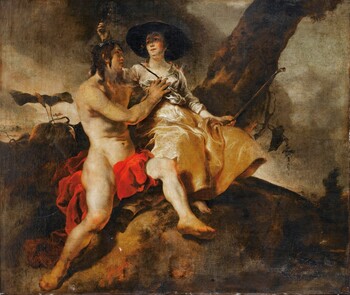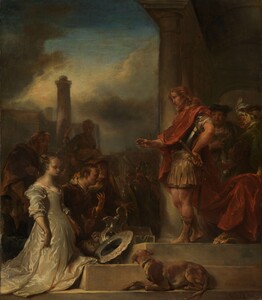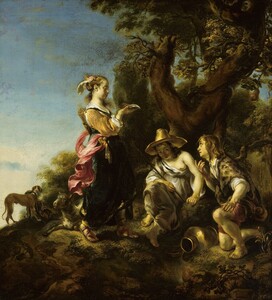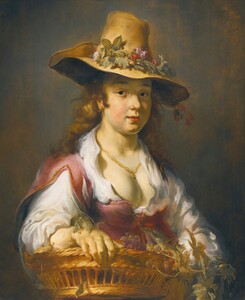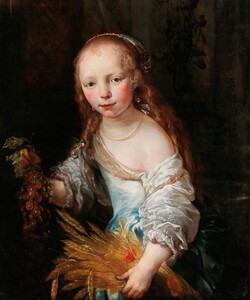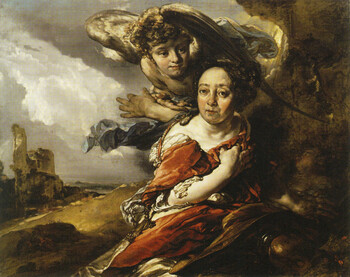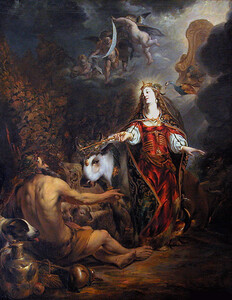12.000 €
The Angel appears to pregant Hagar in the desert
Oil on panel : 84,8 X 114,7 cm
Unsigned
Frame : 102,5 X 131,6 cm
In short
We know that antiques are not stuffy relics from the past. The culture and history of times gone by can help us better understand our modern society. Rarely have I been confronted with this more than during my study of this next painting.
The impact of the Bible on our culture is enormous. Can one state that the inexplicably unjust behaviour of God towards Hagar (and her son Ishmael) is at the root of the Arab-Israeli conflict?
Needless to say today that God works in mysterious ways. Abraham, the first Patriarch of the Old Testament, and his wife Sarah lived to a very, very old age. At the age of 75 Sara finally realised she would never be pregnant, so she proposed Hagar, her slave, to her husband as a concubine. When Hagar fell pregnant the relationship between both women soured and Hagar fled into the desert. An Angel ordered her to return. This is the subject of our painting, but not the end of Hagar’s story and suffering … for at the age of 90 Sara also fell pregnant. Both women had a son. A few years later God decided to disinherit Hagar’s son and had Abraham chase Hagar and Ishmael from his home into the desert.
And here we join our modern history: Hagar’s son, Ishmael was the forefather of the Arabs, Sarah’s son, Isaac, inherited his father’s Hebrew nation. All this of course according to the Old Testament. And even worse: the Angel told pregnant Hagar during her first flight into the desert that her son would have many enemies:
“ He shall be a wild donkey of a man, his hand against everyone and everyone's hand against him, and he shall dwell over against all his kinsmen.”
Jan van Noordt was a successful and versatile painter in Amsterdam until 1672, when the Republic could barely resist a joined attack of England, France, Münster and Cologne. The country and its economy never fully recovered. Van Noordt probably left Amsterdam with no trace in search of a better artistic market; he must have passed away in or after 1676.
About Jan van Noordt
Dutch painter
Schagen 1623/24 – 1676/86 Place of death unknown
He is also known as Joan or as Johannes van Noordt.
Versatile painter of history paintings, that is of biblical and mythological scenes, also of genre scenes and of portraits.
Pupil of Jacob Adriaensz. Backer (1608 – 1651), who is now best-known for his portraits.
Master of Johannes Voorhout (1647 – 1717), who specialised in history paintings, portraits and genre scenes.
Dated works by Jan van Noordt are known between 1644 and 1676.
Jan’s father moved during the 1630s with his family to Amsterdam when his three sons were still fairly young. He was a teacher and a musician, playing the carillon (beiaard) of the Zuiderkerk tower in his new residence, Amsterdam. Both Jan’s brothers became prominent organists in Amsterdam. Their mother died in 1640.
Jan van Noordt artistic career started in the mid 1640s. He had a slow start, but became a successful painter in his hometown Amsterdam during the 1660s and early 1670s.
In 1672, Holland was being simultaneously attacked by England and France, with the help of the bishop of Münster and of the archbishop of Cologne. This period is known in Holland as the “Disaster year” (“Rampjaar”). The troops of King Louis XIV advanced rapidly from Germany towards the W., until they were stopped by the Dutch Water Line, inundated by the new Stadtholder, William III. By 1674 England, Cologne and Munster signed a peace treaty with Holland, while the war with France expanded outside of Holland. The Dutch economy never fully recovered from this disastrous period. Many potential clients lost their entire fortune, so obviously the local art market shrank. Van Noordt’s last dated painting is from 1676. But already in 1673 and in 1674 he gave power of attorney to two other persons to manage his affairs in Amsterdam. In 1675 the owner of a house that he probably had used as an atelier had an inventory made up which could be used in making a claim against debts. Apparently van Noordt did not use it anymore. It has been proposed that our painter had left Amsterdam in search for a better market, possibly in London. There are no more documents about the painter after this last one.
About the subject of our painting
Abraham was the first Patriarch of the Old Testament and the founder of the Hebrew nation. He was married with Sarah, who had been unable to conceive a child. At the age of 75 Sarah offered her servant Hagar, who was an Egyptian slave, as a concubine to her husband. After Hagar became pregnant the tension rose between the two women. Hagar fled into the desert. At a spring an Angel appeared to her and instructed her to return to Abraham, this is the subject of our painting. The son of Hagar and Abraham, named Ishmael, became the progenitor of the Arabic people.
Many years later, when Sarah was almost 90 years old, she finally fell pregnant of Abraham. Their son was named Isaac. The tension between both women rose again rapidly for many years. Sarah finally asked Abraham to send both Hagar and Ishmael away. Abraham followed the order of God to do so and sent them both into the Negev desert. This way Isaac became the sole heir of Abraham. God saved both Hagar and Ishmael: an Angel appeared to them, showing them a well of water. Just as his parents Ishmael lived to a very high age.
So the Angel of the Lord appeared twice to Hagar in the desert:
- once when she was alone and pregnant. This is clearly the subject of our painting.
- Once when she and her young son had both been expulsed by Abraham.
Why should you buy this painting?
Because it has a Rembrandt-like impact. Leiden-born Rembrandt (1606/07 – 1669) lived and worked in Amsterdam simultaneously with Jan van Noordt. There is no direct link with the Master, but van Noordt’s art fits in his circle. Rembrandt produced several drawings, paintings and etchings representing Hagar and the Angel.
Comparative paintings
Click photos for more details

